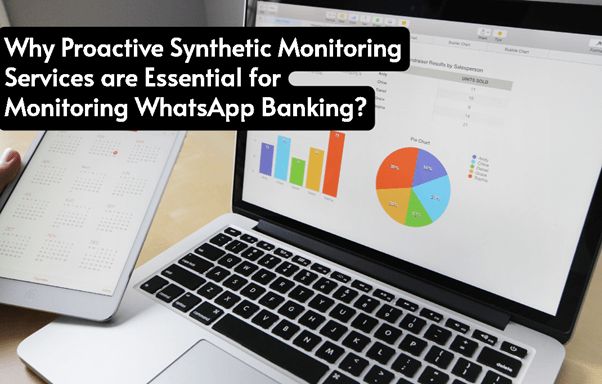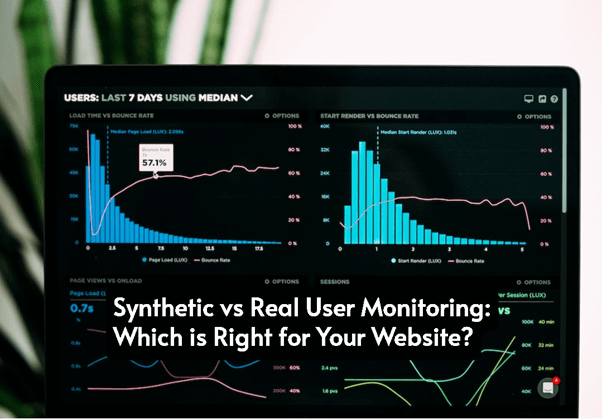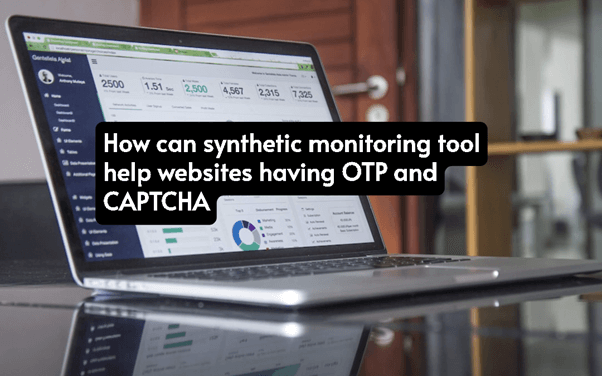What is Synthetic Website Monitoring ?

Businesses are becoming increasingly digital-focused in today’s market environment. The online ecosystem is the new normal for providing services, selling products and more importantly, successful online transactions. For a smoother flow of such transactions, synthetic monitoring (STM) is essential to ensure the application’s performance and generate value out of your digital assets.
What is Synthetic Monitoring?
Synthetic monitoring is a method for analysing the performance of business applications by simulating a path across the application functionalities. It is enabled by defining a route that has several checkpoints. When an end-user goes through the route, each checkpoint indicates the performance metrics to ensure the functionalities are working.
As a result, you have all the KPIs to make alterations in the application code. The paths are consistently monitored for regular improvements to enhance uptime. End-user synthetic monitoring has now become a common practice for business applications with transactional traffic. Thus, it is one of the most crucial IT components for banking and financial apps.
It is also known as directed monitoring as well as active monitoring.

Here are some stats related to application performance and synthetic monitoring:
45% of respondents indicated IT service recovery in 2019 took greater than 12 hours. – Uptime Institute Report
Globally, $126,000 per hour is the average revenue lost due to downtime. – Digital Enterprise Journal
The Synthetic Monitoring market was $838.5 million in 2020. It is growing at a CAGR of 15.2% from 2021 to 2026. By 2026, it can reach $1944.705 million. – Mordor Intelligence
Online businesses worldwide are considering synthetic monitoring as a significant impetus to advance their applications and recover IT issues for maintaining a robust uptime. Especially, banking and finance companies are taking a keen interest to invest more in monitoring services to make the most out of their digital assets.
How does STM maximise application performance?
Synthetic monitoring proactively watches over your APIs, websites, web, mobile and SaaS applications, even during the low-traffic periods, and alerts your operations team in case of performance degradation or availability issues.STM also plays a key role in understanding the performance limitations of your application. Your customers have realistic expectations and automated monitoring techniques fail to deliver real-time resolving. Synthetic monitoring by an end-user may be complex but it surely maximises your application performance by providing real-time data so that you deliver active responses to solve technical issues.
Managing Compliance and Third-Party Integrations
Despite your digital infrastructure, your business app requires third-party integrations to serve transaction requests from multiple sources. This is where synthetic monitoring ensures the reliability and compatibility of the third party. For your application to perform smoothly, you need consistent observation of third-party apps, follow the compliance and get real-time alerts.
Preventing Transaction Failure
Synthetic monitoring helps to prevent an unsuccessful transaction like no other technique. Analysing the previous errors along with accurate incident data in hand, resolving any transactional error is quicker when you have a monitoring partner specialising in STM and end-user analytics. It also includes constant API monitoring with a real user perspective, instant reporting of technical issues, and rechecking the applied measures to prevent transaction failure.
Why should you outsource Synthetic Monitoring?
Unsuccessful transactions due to app failure adversely impacts your bottom-line growth. Most of the business applications under the BFSI sector are outsourcing monitoring to a reliable partner with both automation-driven agility and real user analysis to stay one step ahead.With a significant rise in investments for monitoring globally, businesses are keen to explore new opportunities by understanding application capabilities and error patterns. Your synthetic monitoring strategy should be a blend of rich data analytics and real-time responses to streamline seamless transactions.
Why Proactive Synthetic Monitoring Services are Essential for Monitoring WhatsApp Banking?

With the rise of digital banking, more and more people are turning to their smartphones to manage their finances. WhatsApp banking has emerged as a popular way for people to conduct banking transactions on-the-go. However, with the increased usage of WhatsApp banking, it's important to ensure that the service is working properly and securely. The more efficient, the better the experience. This is where proactive synthetic monitoring services come in. Proactive synthetic monitoring services use software robots to simulate user transactions on a website or mobile app. These robots are designed to follow predefined scripts that mimic user behaviour. By doing so, synthetic monitoring can identify performance and security issues that may affect end-users. Here are some ways in which Unisky Technologies’ proactive synthetic monitoring can help you monitor Whatsapp-banking.
1. Ensuring uptime and availability:
WhatsApp banking relies on an internet connection and servers to function. Any downtime or service interruption can affect the user experience. With synthetic monitoring, you can test WhatsApp banking's availability and uptime from different locations and devices. This helps you identify any performance issues and ensure that the service is available to the users 24/7.
2. Testing functionality and user experience:
Synthetic monitoring can test the functionality of WhatsApp banking, including account creation, login, balance inquiries, money transfers, and bill payments. This helps you identify any issues that may impact the user experience, such as slow load times, broken links, or error messages.
3. Identifying security vulnerabilities:
With synthetic monitoring, you can simulate different types of attack scenarios, such as SQL injection, cross-site scripting, and brute force attacks. This helps you identify any security vulnerabilities in WhatsApp banking and take appropriate measures to mitigate them in real-time.
4. Monitoring third-party services:
Many WhatsApp banking services rely on third-party providers for functions such as identity verification, payment processing, and data storage. Synthetic monitoring can help you monitor these third-party services and ensure that they are performing as expected.
5. Providing insights for improvement:
Technical enhancements in the app code and their impact across the application components can be easily understood by live monitoring. This will help your IT management department to optimise the app’s performance making the brand achieve a significant competitive advantage.
6. App Data Analytics:
Synthetic monitoring can collect data on WhatsApp banking's performance and user experience. This data can be analysed to identify trends and patterns, such as peak usage times and popular features. This can help you make informed decisions about how to improve the service and meet the needs of your users.
Synthetic vs Real User Monitoring: Which is Right for Your Website?

1. Understanding the Differences Between Synthetic Monitoring and Real User Monitoring
Website monitoring is an essential aspect of ensuring that your website is performing well and providing a positive user experience. Two common methods of website monitoring are synthetic monitoring and real user monitoring. While both methods have their own advantages, understanding the differences between them can help you decide which one is best for your website.
2. Exploring Synthetic Monitoring: Simulating User Actions for Website Performance
Synthetic monitoring involves simulating the actions of a user on your website, such as clicking links and filling out forms. This method allows you to detect any issues or errors that may not be visible to real users. It also allows you to proactively identify and fix problems before they impact the user experience.
3. Exploring Real User Monitoring: Capturing User Interactions for Website Optimization
Real user monitoring, on the other hand, involves collecting data on how real users interact with your website. This includes information on load times, browser and device types, and geographic location. This data can be used to optimise website performance and improve the user experience.
4. Advantages of Synthetic Monitoring: Proactive Issue Detection and Scheduled Monitoring
One of the main advantages of synthetic monitoring is that it can be scheduled to run at specific intervals, allowing you to identify issues on a regular basis. This can be especially useful for detecting problems that only occur at certain times of the day or week. On the other hand, real user monitoring provides a more accurate picture of how users are actually interacting with your website, providing valuable insights into user behaviour and website performance.
Another advantage of synthetic monitoring is that it can be used to simulate different user scenarios, such as testing the performance of your website on different devices or browsers. Real user monitoring, in contrast, can only provide data on the actual users that are visiting your website.
In conclusion, both synthetic and real user monitoring have their own advantages and can be used to improve website performance . Synthetic monitoring can be used to detect issues proactively and schedule tests regularly, while real user monitoring can provide valuable insights into user behaviour and website performance. The best approach for your website will depend on your specific needs and goals. It may be beneficial to use both methods in combination to get a complete picture of your website performance. Unisky Technologies synthetic monitoring is one of the best available in the market.
How can synthetic monitoring tool help websites having OTP and CAPTCHA

1. Enhancing Website Security and Functionality with Synthetic Monitoring Tools
Synthetic Monitoring Tools are a valuable resource for websites that use OTP (One-Time Passwords) and CAPTCHA (Completely Automated Public Turing test to tell Computers and Humans Apart) to secure their online transactions and user data. These tools can help website owners and developers to ensure that their website is functioning properly and that users are able to access their accounts and complete transactions without any issues.
2. Testing Website Functionality in a Controlled Environment with Synthetic Monitoring Tools
One of the main benefits of synthetic monitoring tools is that they allow website owners and developers to test their website's functionality in a controlled environment. This means that they can simulate different user scenarios and test how their website responds to different types of traffic and user interactions. For example, they can test how the website responds to multiple users trying to access their accounts at the same time or how it handles high traffic periods.
3. Identifying and Resolving OTP and CAPTCHA Issues with Synthetic Monitoring Tools
Another benefit of synthetic monitoring tools is that they can help website owners and developers to identify and fix issues with their website's OTP and CAPTCHA systems. For example, if a synthetic monitoring tool detects that users are frequently encountering errors when trying to enter their OTP or complete the CAPTCHA, the website owner or developer can investigate the issue and take steps to fix it. This can help to improve the user experience and reduce the risk of users abandoning their transactions or accounts due to technical issues.
4. Optimizing Website Performance with Synthetic Monitoring Tools
In addition, synthetic monitoring tools can also help website owners and developers to optimise their website's performance. For example, they can help to identify areas where the website is slow to respond or where there are bottlenecks in the user flow. By identifying and addressing these issues, website owners and developers can improve the website's overall performance and ensure that users are able to complete their transactions and access their accounts quickly and efficiently.
Overall, synthetic monitoring tools can be a valuable resource for websites that use OTP and CAPTCHA to secure their online transactions and user data. They can help website owners and developers to ensure that their website is functioning properly, identify and fix issues with their OTP and CAPTCHA systems, and optimise their website's performance.
24*7 human support by Unisky Technologies synthetic website monitoring service to enter OTP and CAPTCHA solves hurdles of many businesses having OTP and CAPTCHA on their websites and Apps.
Why do big enterprises prefer outsourcing synthetic website monitoring services instead of in house monitoring tools?

Big enterprises often prefer outsourcing synthetic website monitoring services instead of using in-house monitoring tools for several reasons.
1. Accessing Expertise and Experience: Benefits of Outsourcing Synthetic Website Monitoring Services
First, outsourcing synthetic website monitoring services can provide access to a wider range of expertise and experience. Monitoring companies specialise in providing these services and often have a team of experts with a deep understanding of website performance, as well as experience with various industries and technologies. This can help ensure that the monitoring is thorough and accurate, and that any issues are identified and resolved quickly.
2. Cost-Effectiveness: How Outsourcing Synthetic Website Monitoring Services Can Save Businesses Money
Second, outsourcing synthetic website monitoring services can be more cost-effective than using in-house tools. Monitoring companies can provide services on a pay-as-you-go basis, which can help businesses save on costs associated with purchasing, maintaining, and updating expensive in-house tools. Additionally, outsourcing can help businesses avoid the costs associated with hiring and training additional staff to manage and maintain in-house monitoring tools.
3. Flexibility and Scalability: Advantages of Outsourcing Synthetic Website Monitoring Services
Third, outsourcing synthetic website monitoring services can provide businesses with more flexibility. Monitoring companies can often provide services that are tailored to meet the specific needs of a business, and can scale up or down as needed. This can be especially important for big enterprises, which may have complex, multi-faceted websites with a large number of visitors and transactions.
4. Regulatory Compliance: Ensuring Compliance with Industry Regulations through Outsourced Synthetic Website Monitoring Services
Finally, outsourcing synthetic website monitoring services can also help businesses stay compliant with industry regulations. Monitoring companies can provide services that are compliant with regulations such as the Payment Card Industry Data Security Standard (PCI DSS) which can help businesses avoid potential penalties and fines.
In summary, big enterprises prefer outsourcing synthetic website monitoring services over in-house monitoring tools because it provides access to expertise and experience, cost-effectiveness, flexibility and compliance with industry regulations. By outsourcing these services, businesses can ensure that their websites are performing optimally and that any issues are identified and resolved quickly.